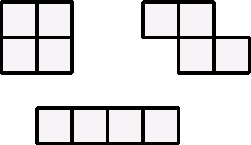Copyright © University of Cambridge. All rights reserved.
'It's All about 64' printed from https://nrich.maths.org/
Show menu
Why do this problem?
This activity is very simple to introduce, yet it has the possibility of opening up a door in mathematics. They are probably very used to a $100$ square and finding out things in different ways. Here the pupils are allowed much more freedom and it is a great opportunity for them to describe to each other what they
notice and to justify their findings.
Possible approach
You could introduce this activity by showing the group a few of the examples given in the problem. Ask them what they notice (and try not to say anything else!) and, after giving them a minute or two, ask them to talk in pairs. Bring them together to share their observations, which may include what the arrangements have in common, their differences, some of the patterns etc. You can then
lead into the first part of the task itself, asking them to design their own shape for the numbers.
If you have a class or a group working collaboratively on this activity, it is good to let the pupils try out a shape and ordering of their own invention without intervening, even though you can foresee a problem with the arrangement. Some triangular arrangements cause problems, but be brave enough to hand over the problem to the pupils so that they can debate about how the numbers and shape
can work well together.
You may like to provide square grids (the same size as the squared paper they are working on) printed on overhead transparencies which the pupils can then cut up to make the frame. It would be good to have a space on the wall or board for you to write up what learners notice about the totals in their frame. Do this as you go round the room so that you can then bring the group together again
once you have a few patterns to talk about. Encourage the children to justify why each pattern occurs - if some are harder to explain at first, leave them on the wall over a few weeks so that there is time for the class to think about them.
Key questions
Tell me about what you have noticed with the frames in different positions.
Can you explain why that happens?
Possible extension
Ask the pupils to suggest some ways of changing the activity slightly so as to produce a new challenge. This could involve looking at a different range of numbers, or having a different number of squares in the tile, but encourage them to ask their own question.
Possible support
You may find it useful to provide cards with the numbers $1$ to $64$ on them and let them explore the ways of arranging them. This helps them see whether the $64$ fit in well to the shape that they want to achieve. There are some carpet tiles about $20$cm x $20$cm available, that are a very good aid when working with a large group together.

